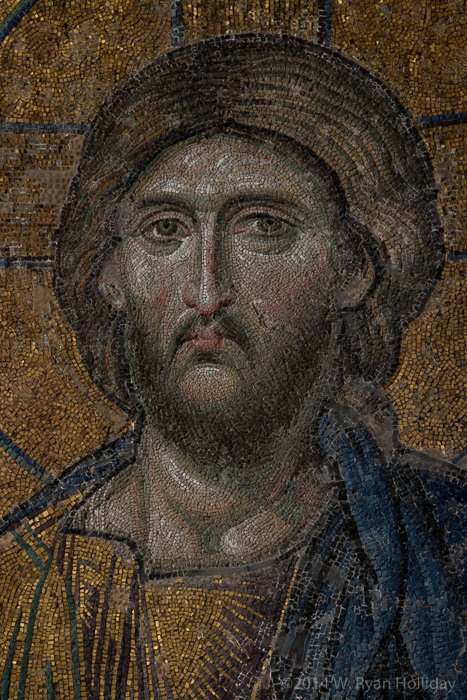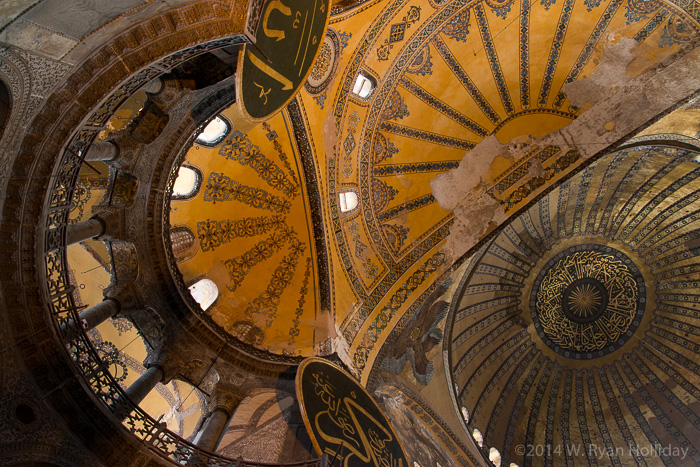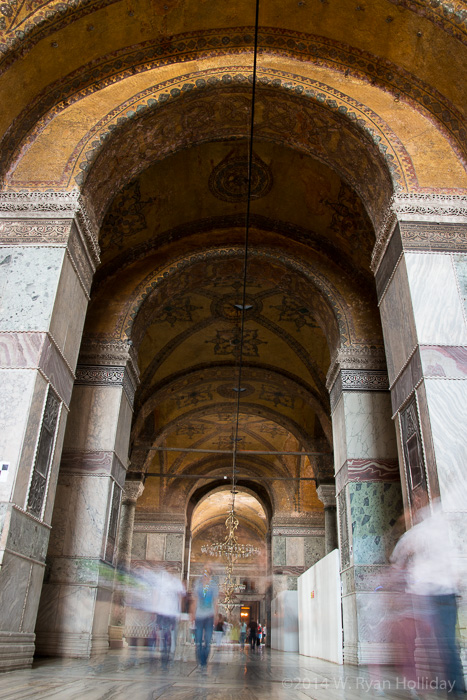News of Africa will follow, but first here are a couple of additional photos from Turkey that didn’t originally make it into the journal; that is truly an amazing country for history and culture, and I had a great time there.
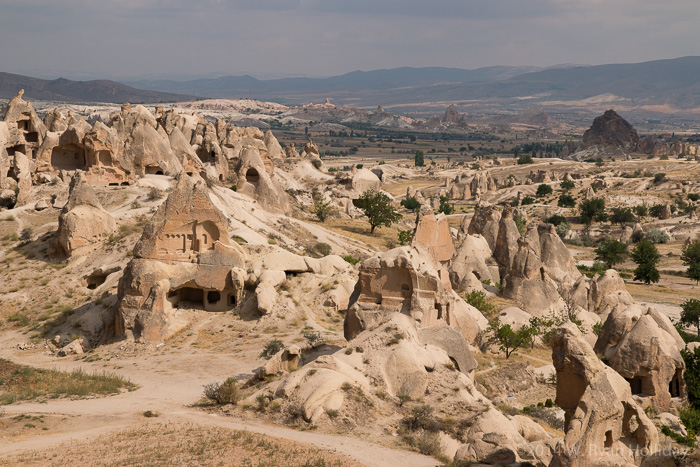
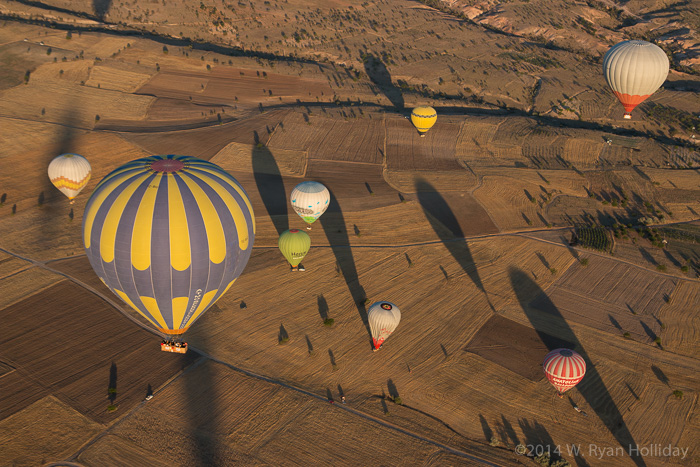
"My life amounts to no more than one drop in a limitless ocean. Yet what is any ocean, but a multitude of drops?" — David Mitchell
News of Africa will follow, but first here are a couple of additional photos from Turkey that didn’t originally make it into the journal; that is truly an amazing country for history and culture, and I had a great time there.


This entry was going to be about how sad it is to leave Turkey, how exciting it is to be going on safari, and how neat it is to be setting foot on three different continents in a single day. However, my plane broke shortly after taking off from Istanbul and had to immediately return to the airport, so I’ll write about that instead.
First, the caveats: the plane was newer and in better condition than most of what we fly on in the US, so any issue had nothing to do with Turkish airlines. Second, whatever happened was probably the flight equivalent of getting a flat tire when driving, i.e. something that just happens from time-to-time that isn’t anything serious. And third, Turkish airlines landed us safely and got us on a new plane in less than an hour, a turnaround time that I doubt any American airline could have pulled off. With that said, the plane took off, and immediately started shaking in a way that felt weird – maybe we hit a bird, or a rotor in the engine cracked or something. A weird smell accompanied this, but any time you fly there’s something that feels a little out-of-the-ordinary, so I figured it was nothing. Then we stopped ascending, and flew low out over the ocean. Also weird, but airspace around Istanbul is congested. Then the pilot came on and made a terse announcement: “there is a problem with the plane, we are returning to Istanbul”. That was it – he said nothing else for the remaining thirty minutes that we were in the air.
I’m an engineer, studied aerospace, and know that commercial airplanes are built like tanks. They can fly across the ocean on a single engine, stay aloft with damage that seems catastrophic, and everything is double or triple redundant. Still, when you’re on a plane, boat, or any vehicle travelling in an environment where you don’t want things to go wrong, there’s still a little voice that lives in the pit of the stomach that is hard to ignore. Knowing that nothing serious was wrong as we repeatedly made circles over the ocean was a different feeling from finally landing again in Istanbul, with the entire plane full of passengers breaking into very loud applause. We taxied directly to the maintenance hangar where six guys immediately descended on the left engine, but beyond that I never found out what had happened.
I’m chalking the experience up to Turkey simply not wanting me to leave, and also treating it as yet another good reminder to almost always let the engineering logic in the brain drown out the dumb guy in the stomach. I write this from the new plane, which took off smoothly, with thoughts of lions to be seen in the coming weeks, fond memories of so many historic sights seen over the past twelve days, and appreciation for the fact that planes are by far the safest mode of transportation.
In an effort to reduce potential driving stress I got up this morning at 6 AM, while most of the vacationing Turks were sleeping, and made an exploration of the surrounding area. Unfortunately it’s pretty developed, so I’ll need to search out the famously beautiful coastline elsewhere in a future visit, but it was nevertheless neat to look at the sea and have the Greek Isles nearly close enough to swim to (nearly – they’re still a few miles away, and I’m not swim team material). I had time for a short hike along the coast before people started waking up, after which I retreated back to the hotel rather than face the horns and congestion of the Turkish roads. Thereafter I decided to make today a rest day, since I’ll likely be too afraid of missing anything to spend much time sleeping during the upcoming safaris in Africa.
Some random thoughts about the trip so far:
Tomorrow is a day of flying, from Izmir back to Istanbul and then on to Arusha in Tanzania. Internet connectivity will likely be spotty in Africa, so posts may be delayed a few days – don’t call the embassy unless I go missing for a couple of weeks. Sadly, there will be no more trekking in ancient Roman cities, but there will be lions…
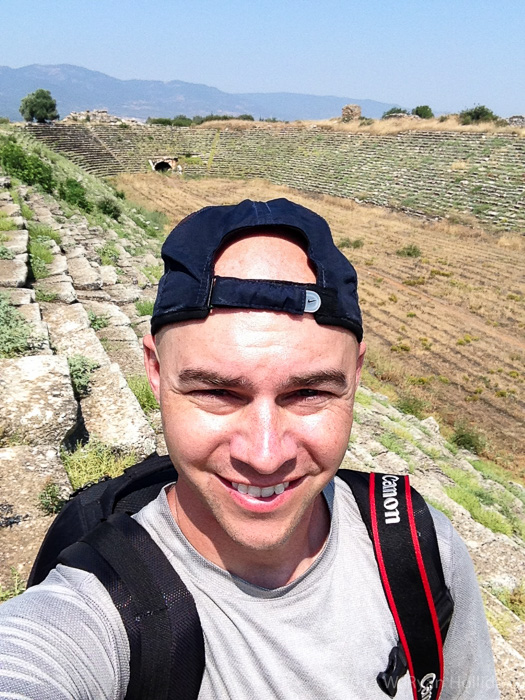
I didn’t make any advance plans for the last few days in Turkey, so the ad-hoc activity for the morning ended up being a trip to Aphrodisias. This was my third ancient Roman city in three days, and it might have been the best of the bunch. There were no crowds – people doing archaeological work outnumbered tourists – and only a small portion of the city had been excavated, leaving lots to explore. There were literally carved blocks sticking out of the ground everywhere, demonstrating how much of the city has yet to be unearthed. What was excavated was in amazing condition – the stadium is the largest and best preserved anywhere in the world, the amphitheatre is in similar condition, and even the marble floors of the baths are still present and intact. The massive agora is also relatively complete, and I got the impression that as they dig more that Aphrodisias will rival Ephesus for the title of “best preserved ancient city”. Finally, the museum contained the most impressive statues and carvings that I’ve yet seen on this trip, I assume because excavations were done mostly after the era in which archaeologists dug things up and then shipped them back home to the local museum. Best of all, I got to enjoy most of these sights on my own – I stood in a 30,000 seat stadium with no one else around, and then repeated the act in the 7,000 seat amphitheatre; the Indiana Jones spirit lives on.
In addition to the history and landscapes, everyone raves about the beaches and coastline in Turkey, so I figured I’d wrap up the trip on the Aegean Coast. A Tripadvisor search for hotels located within 1-2 hours of my departure airport led me to the city of Alacati, so after leaving Aphrodisias I drove four hours west to a town that is sort of like a Turkish version of Carmel. Alacati seems to be a destination primarily for well to do Turks, so it’s a slightly more authentic experience than in other areas that cater more to foreigners. This town would probably have been my dad’s favorite stop, as tonight there was a farmer’s market going on that was easily three times bigger than any farmer’s market I’ve ever seen, with everything from stalls selling dozens of varieties of olives, to stalls selling homemade cheeses the size of a human head, to fruit stalls with watermelons piled six feet high, to carts offering steamed mussels. Pa Holliday would have been reduced to a walking pile of drool.
The plan for tomorrow is to explore some of the nearby beaches, although that option is highly dependent on driving conditions in case some of the “roads” on the map turn out to instead be glorified goat paths masquerading as highways.
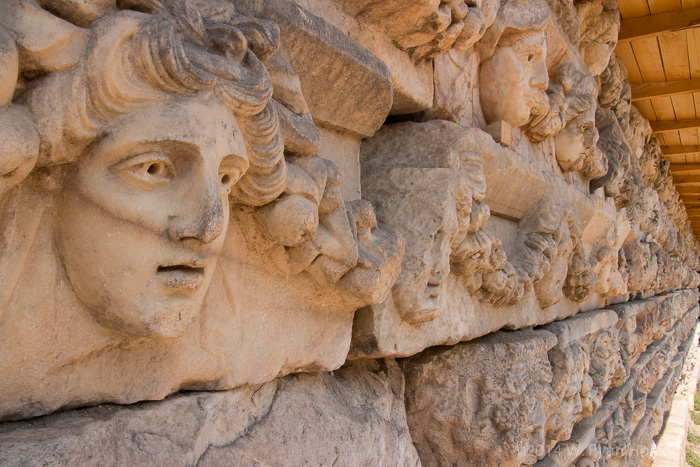
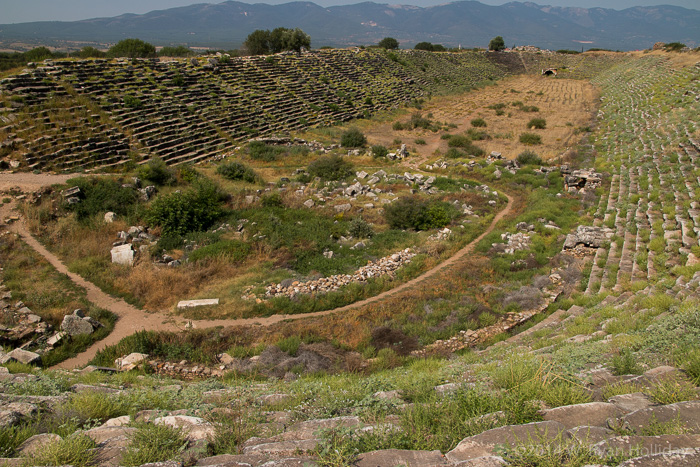
Today ended up with two adventures, one planned and awesome, the other unplanned and not quite as awesome. The latter began after a late lunch when I attempted to save 30 minutes of uphill walking by catching the local shuttle to the upper gate of Hierapolis. The shuttle bus arrived, I hopped on, and my first sign of trouble was that there was not a white face on board. Thirty minutes later the bus finally stopped at the downtown terminal in a nearby large city. Once I found a bus that was supposedly returning to my starting point I made sure to repeat the name of the town I wanted multiple times just to be certain that I wasn’t accidentally getting on an express bus to Istanbul or any other surprise destination. These sorts of things are inevitable when traveling, but it will still be nice to be able to reliably use either English or French in the remaining countries on the trip, since with the aid of a limited vocabulary and excessive hand gestures I might have a decent chance of successfully doing simple things like riding a bus.
The day’s more enjoyable adventure was a visit to the ancient Roman city of Hierapolis. Having already spent an hour of fun in shuttles I gave up on trying to get a ride to the top gate, and made the very pleasant no-shoes-allowed walk up the white travertine terraces, with pools along the route and water from the springs running down the path. At the top, the ancient city sprawled across the landscape. Visits were made to many of the buildings, and one of the things that I’ve learned to love about Turkey is how accessible things are – I climbed to the top of a hill that literally had corners of sarcophagi sticking out of the ground, obviously waiting for archaeologists to find the time to excavate them. Similarly, I’m frequently blown away by the historical significance of what’s here – as if visiting Roman cities wasn’t enough, this one is home to the tomb of Philip. The apostle Philip. A guy who partied with Jesus. You don’t accidentally stumble upon the 2000 year old tomb of a biblical figure in too many parts of the world, but that was just one of several notable discoveries during the day today. The walk back down along the terraces at sunset was a final experience worth savoring for the day.
One last note, but a giant stork has built a nest on the roof of the local mosque and hangs out on patrol for large portions of the day; for reasons I do not understand, I like both that the stork chose the mosque, and that the locals don’t seem to mind having a huge pile of sticks and a large bird on the top of their religious edifice.
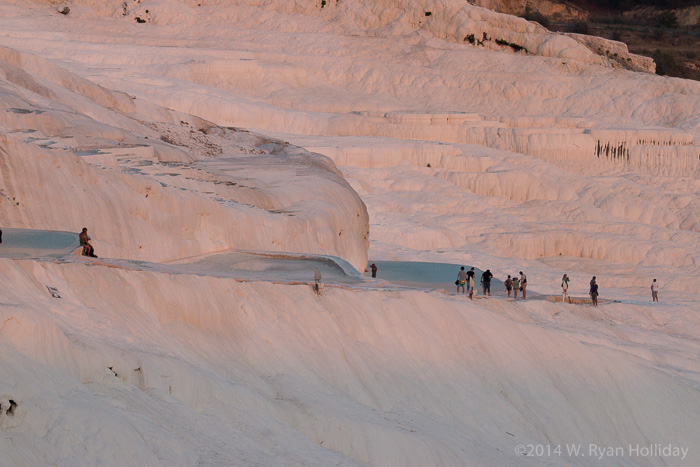
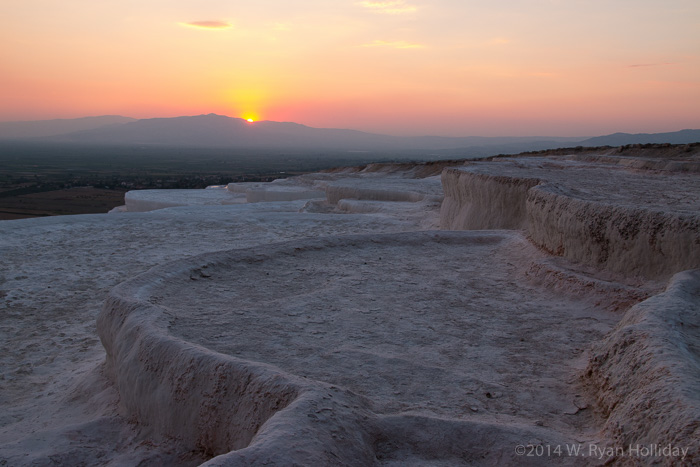
I slept in until 7:15 this morning, and it was glorious.
The plan for the day was to visit the ancient Roman city of Ephesus. The place is so old that it used to be located on the coast, but its port silted up and it is now located a few miles inland. O-L-D. I arrived when the gates opened at 8 AM in an effort to beat the crowds and heat, and then spent nearly five hours exploring ancient ruins and trying to imagine what life was like two thousand years ago. In addition to its theaters and famous library, the town is home to an amazingly well-preserved “terrace house”, complete with frescoes, marble paneling, and mosaics. With a little imagination and some modern amenities, you could easily see how these 2nd century apartments would rival any millionaire’s home today – the Romans were awesome.
By early afternoon I was ready for the three hour drive inland to Pamukkale, home to giant travertine terraces and the ancient Roman city of Hierapolis that sits on top of the travertine hills. I’m sure there was probably a shorter way from Ephesus to Pamukkale, but after yesterday’s fun with “roads”, today I was treating Google Maps with significant skepticism. It still tried to sneak me on to some questionable routes between villages, but as the pavement narrowed I figured out the trick, and spent a half hour backtracking to a more circuitous route that actually had pavement.
I have two nights booked here, and while I had been planning on doing some exploring of the surrounding area after visiting Hierapolis, the option of a rest day in a town that has been known for two thousand years for its hot springs sounds very appealing after the frantic pace of the past ten days.
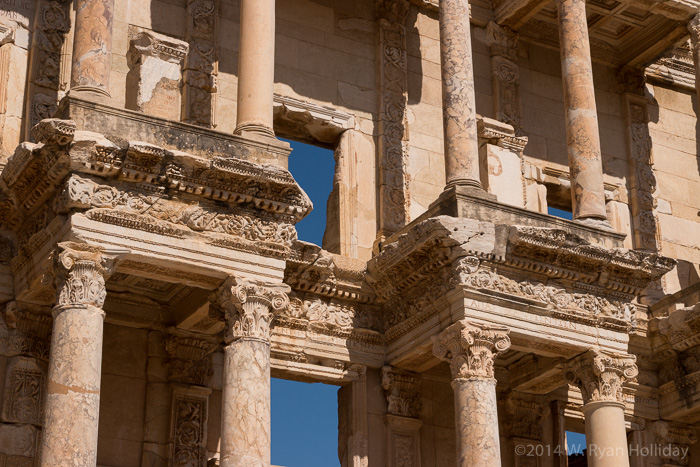
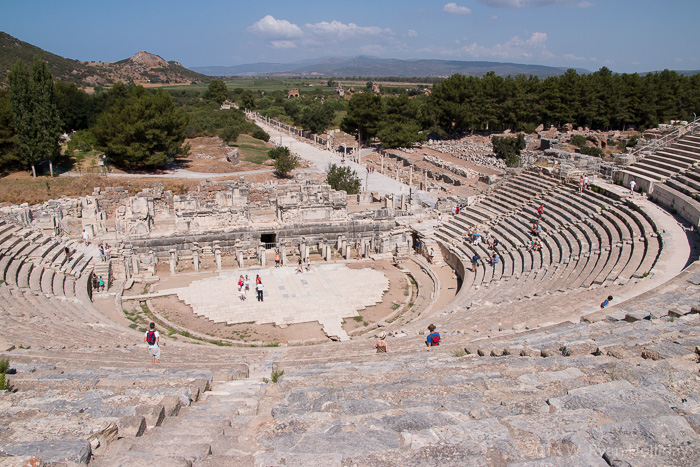
It’s pretty cool when you feel like you’ve gotten in a full day’s worth of activity, look at the time, and realize it’s only 6:30 in the morning.
The hot air balloon ride was totally worth doing. The pilot of our balloon was apparently some sort of otherworldly wizard who was capable of sending the balloon three thousand feet into the air before dropping down to within a foot (literally) of the canyon walls for a few minutes, and then lifting us up a thousand feet before repeating the maneuver in a new canyon. The trip started in the pre-dawn hours, and the balloon lifted off so gently that the only indication of flight was that the ground was becoming distressingly far away – it’s an unnerving sensation to be leaning over the side of a basket a half mile up in the air with nothing supporting you. We watched the sunrise from that height with a hundred other balloons surrounding us, then the balloon armada dropped down to float together through the canyons before repeating. The weather conditions were apparently perfect, and after an hour in the air we landed softly next to the waiting trailer. The much feared presentation of the “flight certificate” was as painful as I imagined it might be, but despite that bit of tackiness I would still highly recommend the experience.
Following the balloon ride I was back at the hotel by 7 AM, grabbed a quick breakfast, and then did a return visit to hike in the Rose & Sword Valleys in order to enjoy the Indiana Jones spirit one last time. Sadly, after that it was time to check out of the incredible, stupendous, and ridiculously great cave hotel, and then it was off to the airport to embark on stage three of the Turkish odyssey.
For my last five days in Turkey I’ve put my life on the line by renting a car and facing the wrath of the Turkish roads, with tonight’s first lesson being that a “road” on Google maps may be something that causes locals to jump up from their seats and yell out warnings when you try to drive on it, necessitating a long drive of shame in reverse along a narrow, one-lane cobblestone path. Assuming the necessary lessons are learned without incident and I can survive this new motorized portion of the trip, in the coming days I’ll get to see a mix of ancient and natural wonders that were old even in biblical times. Life continues to be very, very good.
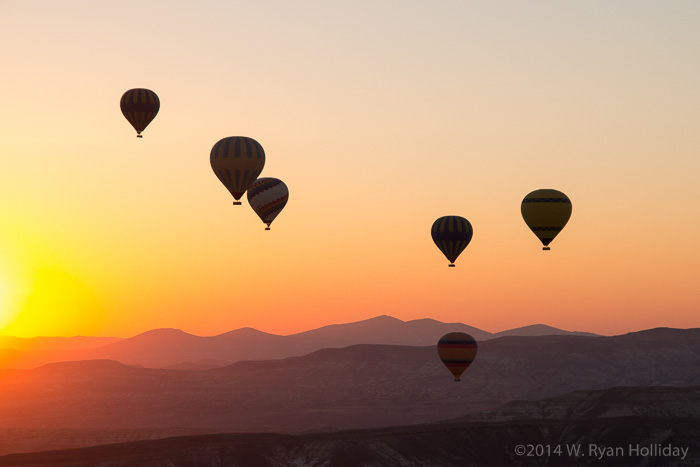
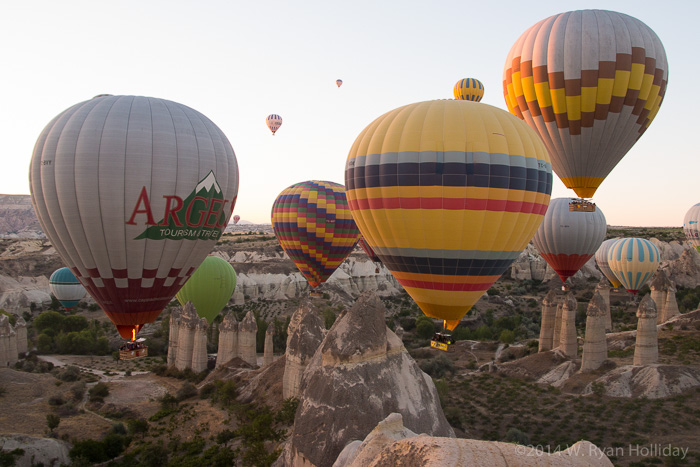
The 2006 Galapagos trip was referred to (fondly, by most) as the “active trip” since we packed in non-stop activity. Thus far this adventure is definitely living up to the standards of the active trip, with the added element of massive numbers of hills. My legs and feet appear to still be on speaking terms with the rest of the body, but I fear that if this pace keeps up there will be unrest and threat of strike from my appendages responsible for locomotion.
Today was much like yesterday, with less Indiana Jones and much more finely painted stone churches. The day began before 4 AM with the man in the mosque singing me a song through the loudspeakers on the minaret. This particular melancholic lament was considerably longer than his normal pre-dawn melodies, and when it finally ended sleep was hard to find. Finally at 5:30 I went up to the terrace to again watch the balloons floating by, and thereafter it was off to the protected area of Goreme to see the most impressive of the stone churches. This area is actually managed as an open air museum, so it was quite a different experience from the previous day’s journeys into lonely corners of hidden valleys. Photos were not allowed and, since I’ve already gone on ad nauseam about how amazed I am that anyone could have built such structures inside of solid rock, like Forrest Gump I’ll sum up by saying that’s all I have to say about that.
After visiting the pretty churches the first attempt at a hike for the day ended in defeat as the trail through the Zemi Valley simply faded away, and I couldn’t for the life of me figure out where it had gone. Ego in hand, I made a one-eighty and came back to my ridiculously awesome cave hotel for a nap and to avoid being out in the heat of the day. Nap completed, I then headed off for a late afternoon hike in Love Valley, which I swear has to be a toned-down translation of the actual Turkish name since it was named after the giant stone formations that are found throughout the valley floor, each one looking exactly like a fifty foot tall weiner.
Tomorrow is my last day in Cappadocia, and I reluctantly shelled out the big bucks to take a ride at sunrise through the valleys with Istanbul Ballooons. A hot air balloon ride has to be the most touristy thing I could possibly do – all the balloon companies advertise that after landing they have a champagne celebration and present you with a “flight certificate”, which hurts my soul in the most severe way – but I’m hopeful that this one is a truly great experience that comes with a side of touristy schlock. Following the balloon ride there should be time for one more hike, and thereafter the second leg of this trip will have all-too-quickly come to a close.
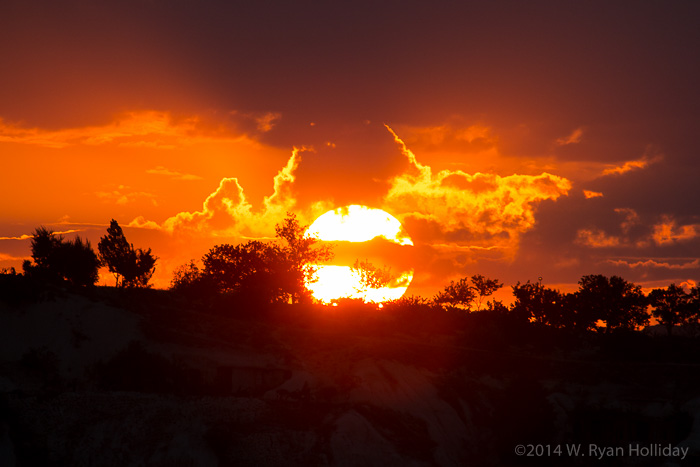
Yesterday I woke up at 6:15 and counted 26 hot air balloons floating across the sky. Today I woke up at 5:45 and there were too many to count. Six days in, and this adventure is still going very strong.
Prior to arriving I knew nothing about the logistics of visiting Cappadocia, and not wanting to lose even one day of this trip I had made advance arrangements with a trekking company for the first day here. After arriving I realized that there is TONS of great history and landscapes surrounding Goreme (the town I’m staying in), so today I was happily able to return to my lone, free ranging ways. A hike through any of the surrounding valleys literally passes by hundreds, if not thousands, of stone structures that date back a couple thousand years, so I was in full-on Indiana Jones mode as I scrambled through ancient churches that had been hacked from stone, roamed through eroding rock formations, and explored old monasteries that crept up multiple levels inside of the rock. Without trying to sound like a broken record, it’s unbelievable what people have been able to carve out of the rocks here – at one point today I stood in a church that was three stories high, all chiseled out by hand deep inside of a cliff.
After returning in early afternoon and getting a much-needed nap during the heat of the day, the late afternoon activity was a visit to Uchisar Castle, which is the high point in this area, and which was hacked out of the top of a stone hill (of course). From there it was a nice stroll back to Goreme through Pigeon Valley, so named for the high density of pigeon houses carved into the cliffs and built by ancient people since they used pigeon droppings for fertilizer.
One last note, put here mainly for my dad – no matter where I travel, his first question is nearly always about the food (“Antarctica, huh? What was the food like?”) Gotta say, while I haven’t been spending much time eating, Turkey does the culinary thing right. Best olives I’ve ever had. Fresh fruit that is smaller than what we get back home, but seems to pack in more flavor. Grilled meats that have all brought great joy to the tastebuds. And while I’m not yet a card-carrying member of the Turkish tea fan club, I could see how that ubiquitous drink would grow on you. The only downside for me has been that this is the wrong place to not like eggplant – at one point I politely declined some sort of curried eggplant from the guy working the breakfast buffet, and while he didn’t say anything out loud, the look on his face was pretty clearly one of very deep-seated disgust towards me and all of the evil that I represented. In my defense, I had tried the dish he was offering earlier and re-affirmed that eggplant continues to keep its position on my unapproved vegetable list.
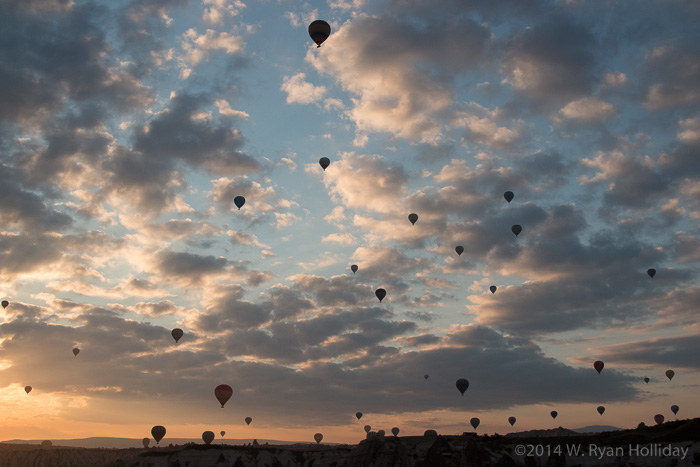
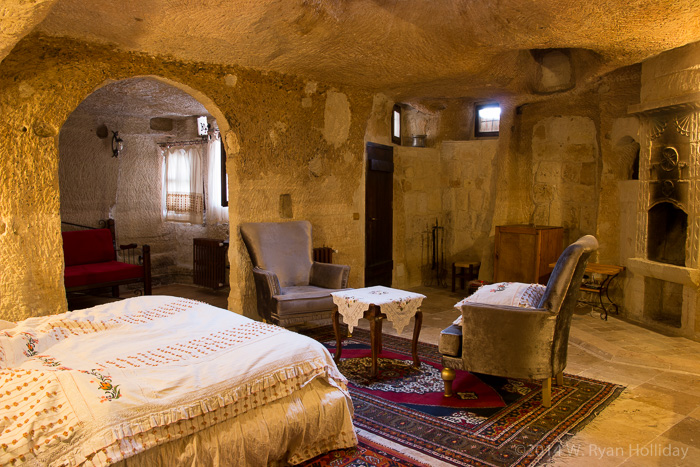
I woke up at 6:15 this morning, walked up to the uppermost terrace of my cave hotel, and watched 26 hot air balloons floating over the rock formations. Life is that awesome right now.
The day’s plan was to hop in a van and go see evidence of civilizations that were here millennia ago, starting with the Kaymaklı Underground City. The “city” part of the name is actually accurate – ancient people hacked the rock to build tunnels and living quarters that are large enough to hold 4000 people with enough supplies to withstand sieges from invaders for several months. The underground labyrinth has at least 100 rooms that extend below the surface for eight levels and a depth of at least 70 meters, with the oldest portions dating back as far as 2000 BC. I had no idea such a thing had ever existed in this world, but seeing the lengths ancient people were willing to go to in order to escape from invaders made me very, very appreciative that I live in a time when it is no longer necessary to deal with surprise raids from barbarian hordes.
The next stage of the journey was an eight mile hike through the Ihlara Valley, a hideout for early Christians escaping religious persecution (at that time “religious persecution” was a euphemism meaning “a horrible, awful, terrible death”, so the hiding was mostly justified). Cave houses were everywhere, and hidden churches appeared at regular intervals. Sadly the frescoes in the churches were heavily obscured by graffiti – “crazy lovers” was how the guide I was with described the perpetrators – so works of art dating back to the first few centuries AD are now victims of visitors who felt it was important to scratch their initials and the date of their visit into the ancient plaster. JC would have been forgiving, but it gave me a significant frowny face inside.
With all of the day’s activities there wasn’t time to take photos of my uber-awesome cave hotel room, so those will need to wait for a later journal entry when extreme tiredness isn’t such an immediate concern.
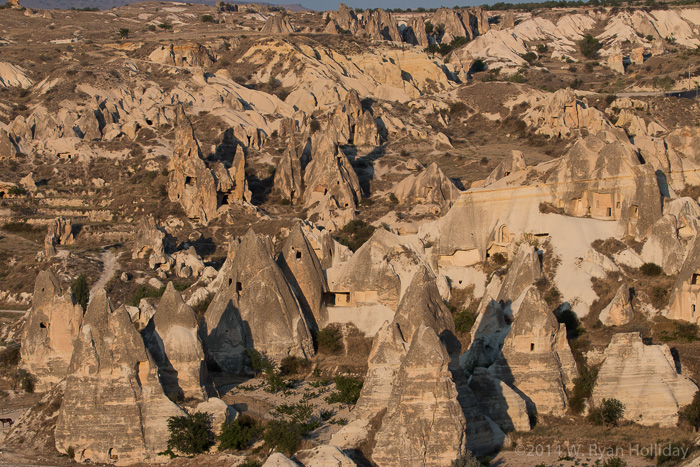
The days when it was a struggle to find subject matter for three journal entries a month are gone… I’ve just arrived in Cappadocia, and this journal entry would be all about my 300 year old carved-out-of-solid-rock cave hotel room(s) if there wasn’t more to recap from Istanbul. The high level overview on the lodging for the next four days: if you’re ever planning a trip to Cappadocia and think it might be better to save some money and not stay in a cave hotel, have someone immediately slap you across the face, hard. You will later thank them repeatedly after not missing out on the most unique accommodation experience of your life.
Now back to Istanbul. Thus far I’ve been going to bed early and waking up even earlier, so last night was the first night where I ventured out in the evening. Ramadan is ongoing, and when I got to the main park outside of the Blue Mosque there were literally thousands of people having picnics with their friends and families to break their daily fast. I’ve never seen anything quite like it – imagine the scene on the Fourth of July just before they shoot off the fireworks, but no one is American, the food is completely foreign, and the music and games are unrecognizable; that sort of captures it. It was incredibly neat to just walk around and absorb the atmosphere.
After last night’s meandering I got up reasonably early today for my final day in Istanbul. The first destination was to the 7AM opening of the rooftop restaurant at the Seven Hills Hotel to soak in the 360-degree views of the ocean, the Blue Mosque, and the Hagia Sophia in the early light. “Soak in the views” might be a cliched term, but in this case the surroundings really were sort of like fuel for the soul.
With the spirit refreshed and the belly full of olives and honeycomb, the activities for the day were a trip to the Little Hagia Sophia and to the Basilica Cistern, followed by an interlude at the Blue Mosque prior to heading to the airport to catch my flight. The Little Hagia Sophia was actually built by Justinian before the Hagia Sophia and, unsurprisingly, is a much, much smaller version that has less ornate decoration but some amazingly impressive carved marble columns. A thunderstorm arrived while I was there, and I was trapped in a 1500 year old church (now mosque) for an hour; that is misfortune of the very best kind. The Basilica Cistern is a 1500 year old underground Roman water storage tank, which doesn’t sound so neat until you’re in it: it is 453 feet long, 212 feet wide, 30 feet high, and supported by 336 marble columns – it’s also known, understandably, as the Sunken Palace, and probably ranks in my top ten most unexpectedly weird discoveries. The support columns were re-purposed from other structures, so most of them are ornately carved with different designs. Rumor has it that it was forgotten until the 16th century when a scholar researching Byzantine antiquities was told by locals of how they could catch fish through holes in their basement floors, and carp are still present today in the two feet or so of water that floods the bottom. Wandering around inside re-affirmed my belief that had Rome not fallen, their genius would have had us launching satellites and making microwave popcorn five hundred years ago.
Thus ended the very first leg of this three-month long odyssey. Tales of the cave hotel, hidden churches, and attempts to avoid heat stroke will follow tomorrow.
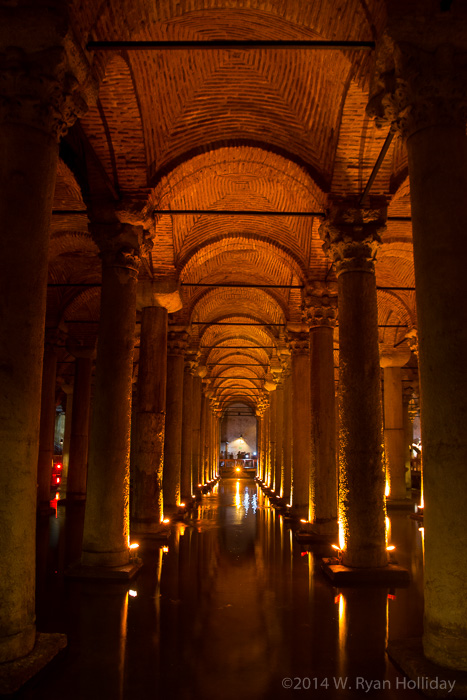
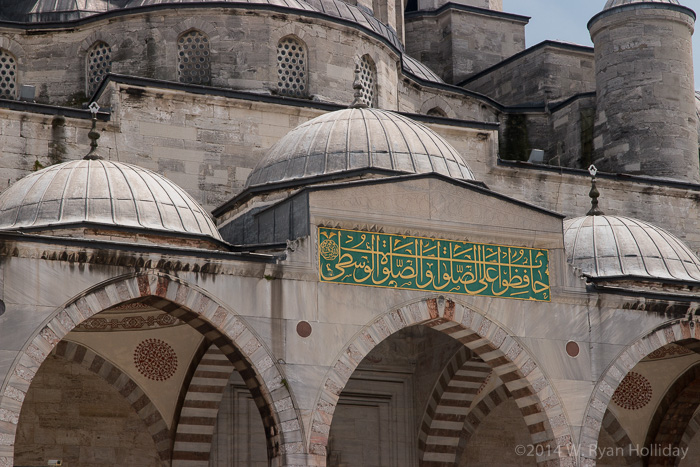
After walking all over Istanbul in the heat today I sat down while inside of the Archaeology Museum to rest my (very, very, very) tired legs and accidentally dozed off – I could be wrong, but I think that means I’m doing this adventure thing right.
It’s shockingly difficult to find a nice view of Istanbul’s Old City, but after scanning the horizon I noticed people dining on the roof of the Seven Hills Hotel and the day started with me heading over there to catch the morning light. Surprisingly they didn’t insist that I buy anything, and for the equivalent of a couple of dollars gratuity I started the day with a great view of the sea, the Blue Mosque and the Hagia Sophia – there may be a return visit tomorrow.
From there the day of much walking commenced, with a journey across the Old City and through all manner of narrow alleys to the Grand Bazaar, Spice Bazaar, Suleymaniye Mosque, Archaeological Museum, and along the waterfront. My expectations for the Grand Bazaar may have been a tad unrealistic – I imagined a labyrinth of shops straight out of the Arabian Nights, with artisans, exotic goods, hookahs, and maybe a camel or two. The labyrinth part was accurate and very cool, but the shops themselves were more flea market than Arabian Nights, and there wasn’t a camel anywhere to be found. The Spice Bazaar came closer to matching my imagination, with brightly colored bins of spices laid out in hundreds of stalls. Even better were the shops in the narrow alleys around the spice market, where labels weren’t printed in English and none of the goods were being sold pre-packaged in gift baskets.
From the Spice Bazaar it was uphill to the Suleymaniye Mosque, which is slightly older than the Blue Mosque, approximately the same size, equally as impressive inside, and filled with perhaps 1/20th as many tourists. Also, it’s less blue and more red.
The day finished with a slow meander towards the Archaeological Museum, through innumerable narrow cobblestone alleys, across public squares, and past all manner of shops. When finally it occurred to me that some sort of sustenance might be a good idea I ordered a kebab, and after I answered in the affirmative when the guy making it pointed to some french fries, I learned that in Turkey they are apparently toppings rather than a side dish, as they came wrapped inside of the kebab – yet another tiny reminder that I am far from home. Hopefully I can get my tired legs to cooperate and do a bit more wandering tomorrow, after which I fly out of Istanbul in the evening and head to the weird landscapes of Cappadocia for the second leg of this adventure.
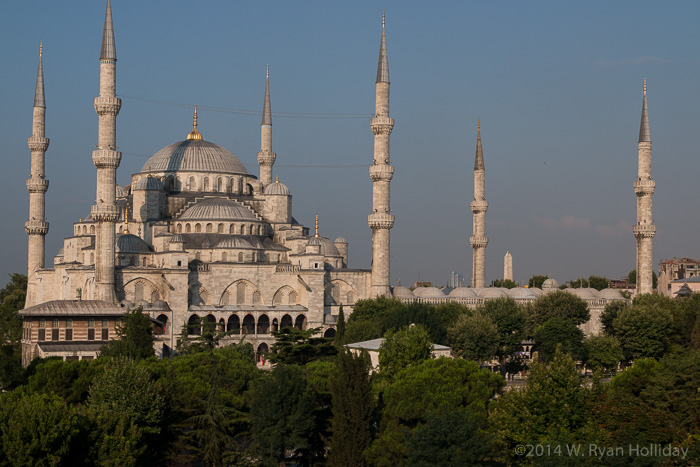
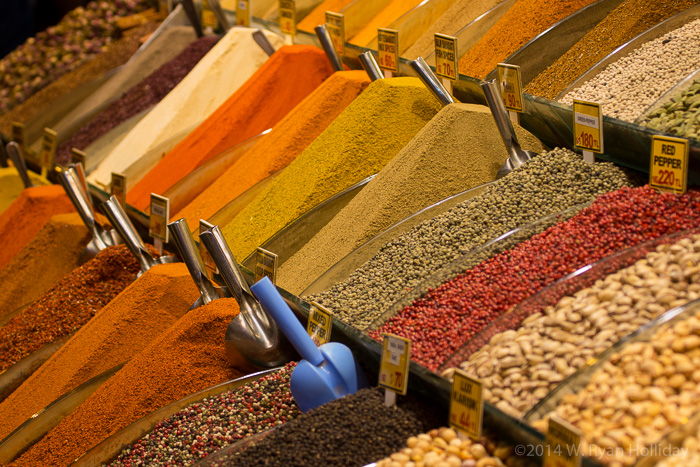
The tour groups filtering through the Blue Mosque seemed to allow about fifteen minutes to visit the place, which means I probably saw nine rotations go through while I enjoyed the cavernous interior – at the rate I’m going, four days will be enough to see only a tiny, tiny fraction of Istanbul.
By the standards of Istanbul’s other monuments, the Blue Mosque is fairly young, having been built only 400 years ago, but it is equally as impressive as its older siblings. 20,000 handmade tiles decorate the inside walls and pillars, the central dome rises 141 feet into the air, eight supporting domes create a huge interior space, and one awed and smiling American got to enjoy it all for a good chunk of the morning.
The day’s next visit was to the nearby Mosaic Museum, which is the remnant of a 4000 square meter mosaic courtyard built by Justinian about 1500 years ago that, for whatever reason, was mostly built over and forgotten as the centuries passed by. Today archaeologists have restored a portion, and I’d put the artists who built it up against any artist living today – it’s an impressive piece of creative work. Following that stop it was back to the Hagia Sophia to see the tombs of four sultans. All of the tombs were inside of large domed buildings, all impressively decorated with tiles, and the actual sarcophagi (?) were carpeted on the outside, which I guess is the way you do it when you’re a sultan (or a relative of a sultan) of one of the largest empires ever to exist on Earth.
Thereafter it was off to the Topkapi Palace, the seat of the Ottoman Empire from 1465–1856. The palace grounds included four courtyards and hundreds of rooms, leading to a tired set of legs when all was said and done. The Sultans lived well, as evidenced by the residence area (the Harem), the museum exhibits that included an 86 karat diamond and bowls filled with emeralds, the ornate receiving rooms, and the tremendous views out over the Bosphorus Strait. The day’s final visit was to the Hagia Irene, a church that is slightly older than the Hagia Sophia but slightly less massive and in a much greater state of disrepair. Surprisingly, the worn down old building is used today primarily for musical performances, as it apparently has amazing acoustics under its high dome.
Finally, random side note, but while the focus on wildlife for this trip won’t start for two more weeks when I reach Tanzania, it’s impossible not to notice that they have (very loud) parrots here, too. In addition, there are a surprising numbers of birds that have found holes in the exteriors of the historic buildings and set up homes in hidden corners of architectural wonders. Hearing a pigeon flying through the vast interior of the Hagia Irene or Hagia Sophia isn’t what I necessarily expected in the stillness of a 1500 year old religious edifice, but at the same time it definitely doesn’t detract from the ambiance.
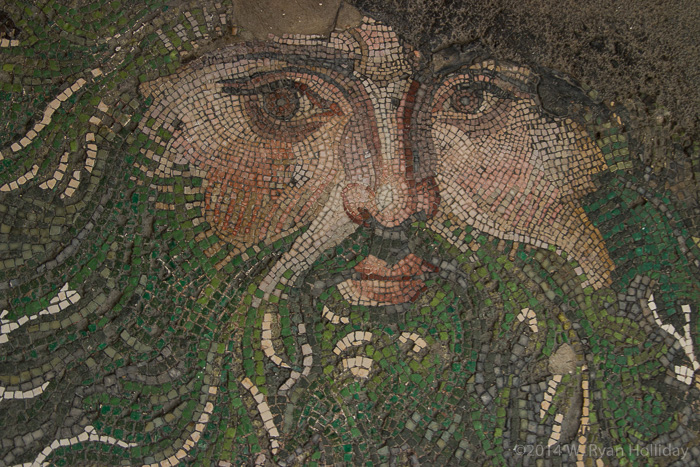
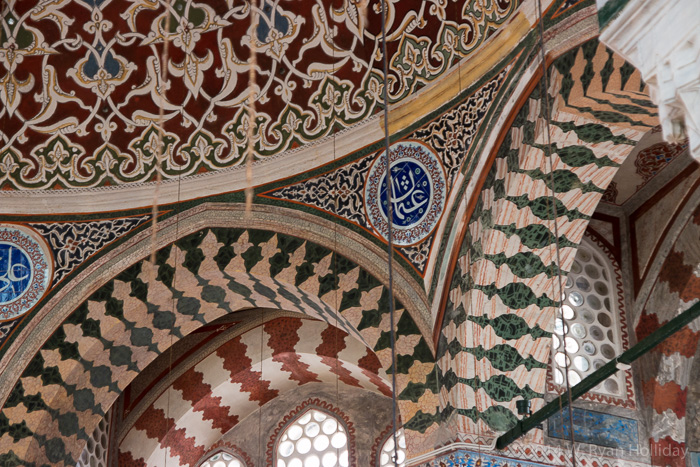
Yesterday’s plan to avoid jet lag despite sixteen hours of flying and a ten hour time change was simple – get up to catch the plane at 4:30 AM (Los Angeles time) and then stay awake until I was somewhere over the Atlantic and it was the equivalent of evening time in Istanbul. A brilliant plan, had it worked, but instead I never fell asleep on the plane and arrived in a state resembling the walking dead. On a positive note, I finally got to see Captain America 2, Thor 2, and the Hobbit Part 2 (Air Canada is really into sequels).
After landing and fetching luggage I arrived at the hotel in Istanbul at noon local time (2AM Los Angeles time), and fearing that it might not be a good idea to see some of the world’s most amazing landmarks while hallucinating, took a three hour nap before heading out. Once off, my hotel was only a couple of blocks from the Hagia Sophia, so I got to spend the remainder of the day in one of the most remarkable buildings ever built by humans. The place is old – it was built in 537 AD, and is the kind of old where you look at a marble block at the entrance and notice that it has been worn down two inches in the center from people walking on it. In addition to its age, the building is an architectural marvel that, like the pyramids or Stonehenge, makes you wonder how societies of that time could possibly have built it. The central dome alone is 101 feet across and 160 feet high, creating an absolutely immense enclosed space. I stayed well past closing, allowing the crowds to thin out, and got to enjoy the place as it got quieter and stiller; not a bad way to kick off this adventure.
The Blue Mosque faces the Hagia Sophia from across a park, so I ventured over to it as the sun was setting. It was too late to go inside, but standing in the courtyards finally gave me that electric shock feeling that yep, I’m far from home on the opposite side of the world. Hearing people speaking Turkish, not knowing what the customs were, navigating narrow cobblestone streets, wading through the touts in the park (“My friend! My best friend! You want Bosphorus cruise?”), and being awed by a sight I’ve wanted to witness for decades was just the right combination to let it sink in that I am most definitely on an amazing adventure.
